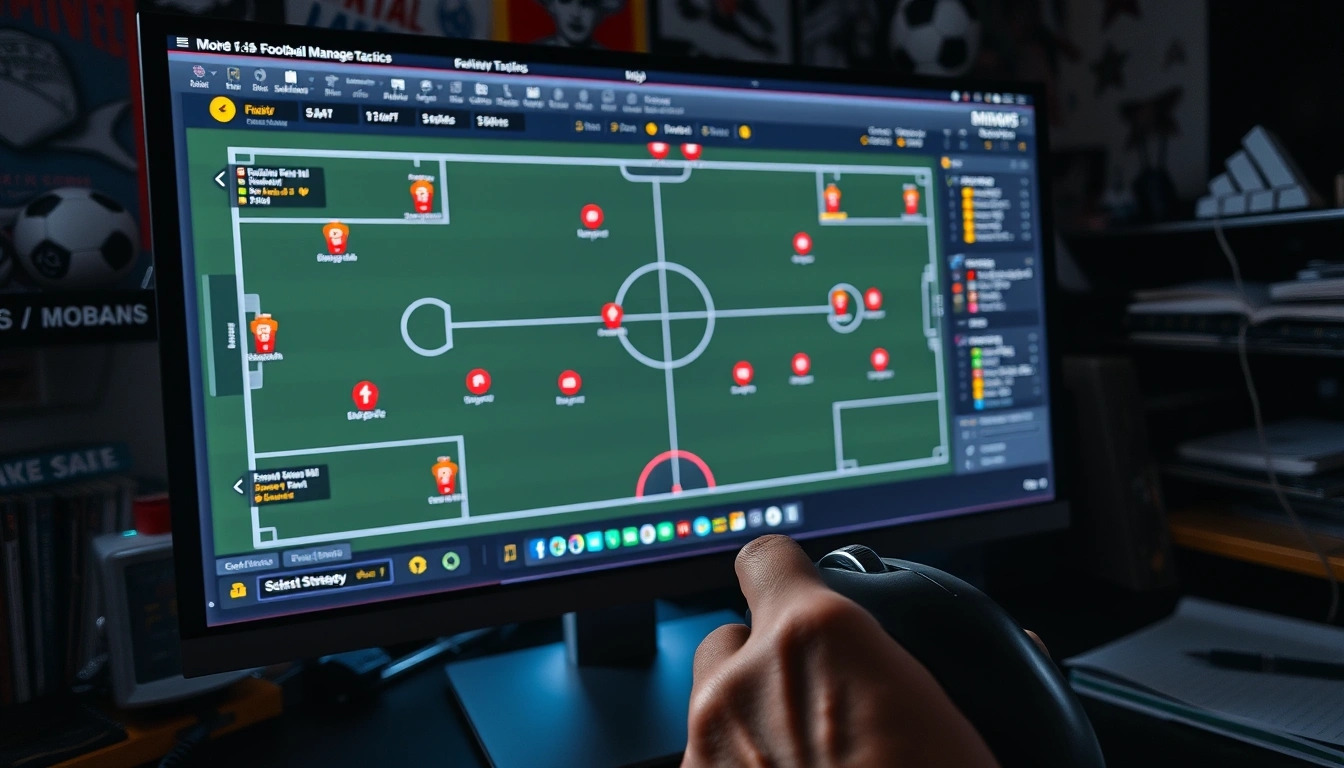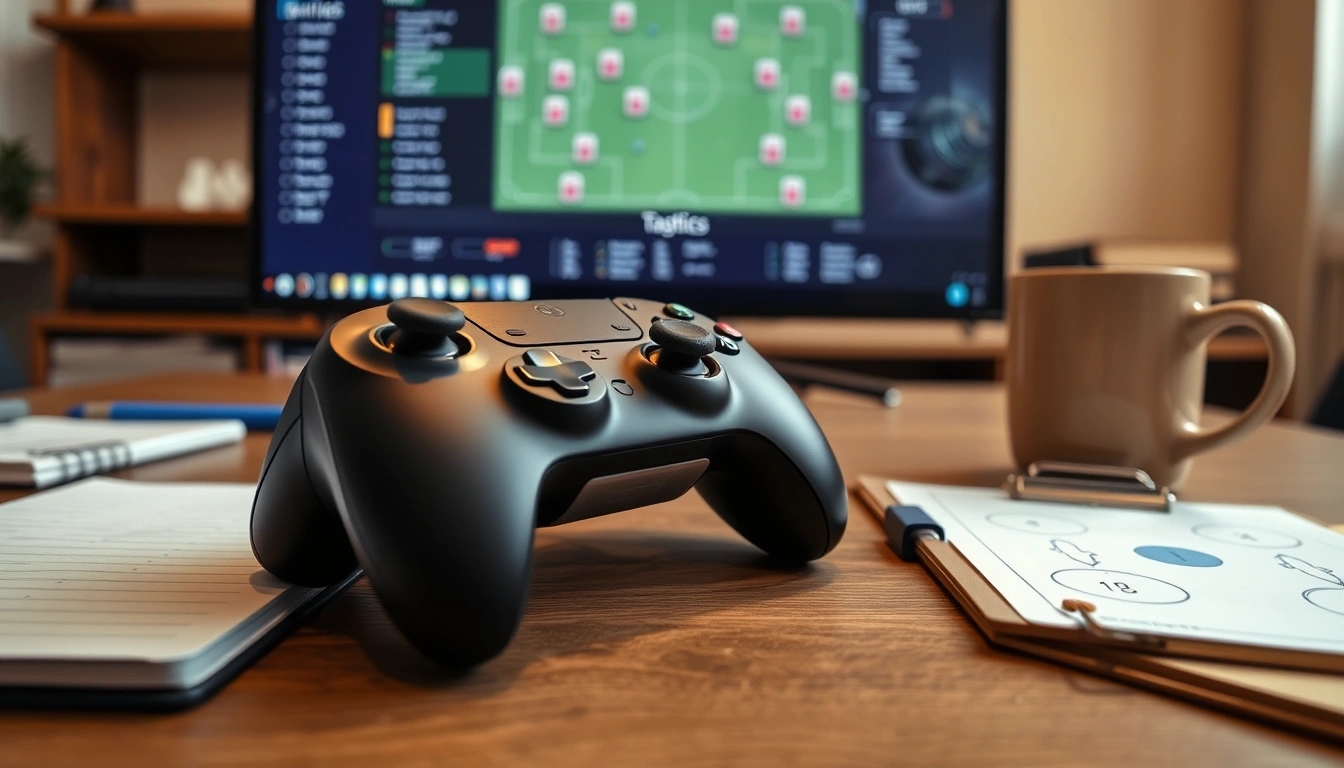Alright, let’s talk about football video games—not just the flashy goals or nutmegs, but the stuff that really gets your brain ticking: tactics. You might think, “Hey, it’s just a game,” but nah, these games can actually sharpen your strategic thinking and decision-making on the pitch. Whether you’re a fan trying to understand the game better or a player wanting to get a leg up on your tactical awareness, some football games offer surprisingly realistic practice grounds.
Now, why do these games matter so much for tactics? Well, they simulate real match situations where you’re not just kicking the ball around but thinking about formations, player roles, and how to outsmart your opponent. It’s like having a mini coaching session right in your living room. And for coaches, these games can be a handy tool to visualize strategies without sweating it out on the training field.
| Game Title | Key Tactical Features | Best For |
|---|---|---|
| FIFA Series | Dynamic formations, player control, Manager Mode | Casual gamers, fans of realistic gameplay |
| Football Manager | Deep tactical customization, player roles, transfer market | Strategy lovers, aspiring managers |
| eFootball (PES) | Realistic gameplay, tactical nuance, AI behavior | Players seeking a tactical challenge |
Take the FIFA series, for example. It’s not just about scoring screamers; the game’s tactical depth is pretty impressive. You get to tweak formations on the fly, adjust player instructions, and feel the pressure of making split-second decisions. The Manager Mode? Oh boy, it’s like running your own club. You juggle transfers, lineups, and tactics, which is a neat way to understand the complexities behind the scenes.
- Formation flexibility: Switch between defensive and attacking setups seamlessly.
- Player roles: Assign specific duties like playmaker or target man.
- Match analysis: Review your performance and tweak strategies accordingly.
Then there’s Football Manager, the heavyweight champion of tactical depth. This game isn’t for the faint-hearted or those who want instant gratification. It’s a slow burn, requiring patience and a love for details. You can micro-manage everything from player mentality to set-piece routines. If you enjoy dissecting every little tactical nuance, this is your playground. The ability to create custom tactics and assign precise player roles lets you experiment endlessly—sometimes you win big, sometimes you crash and burn spectacularly.
And don’t overlook eFootball (formerly PES). It’s often overshadowed by FIFA but brings its own flavor to the table. The gameplay feels more grounded, focusing on realistic ball physics and subtle tactical shifts. It’s a bit like the underdog in the tactical football gaming scene, but once you get the hang of it, it offers a refreshing challenge.
Quick tips when choosing a tactical football game:
- Look for games with flexible formations—you want to test different setups.
- Check if the AI adapts to your tactics—static opponents are boring.
- Does the game offer post-match analysis? It’s gold for learning.
Now, before you get too hyped, remember these games aren’t perfect substitutes for real-world practice. They can’t replicate the physicality or unpredictability of an actual match. Still, mixing gaming with on-field training? That’s a combo that might just give you the edge.
In the end, whether you’re managing a team from the couch or trying to outwit your friends online, football video games offer a surprisingly rich tactical playground. So next time you boot up your console, don’t just chase goals—think like a coach, plan your moves, and maybe, just maybe, you’ll see those skills translate on the real pitch.
Why football video games matter for tactics
Football video games have come a long way from simple pixelated kickabouts to complex simulations that mirror the beautiful game’s tactical intricacies. Now, you might be thinking, “Come on, how can a game really help with real-life football tactics?” Well, buckle up, because the answer is more nuanced than you’d expect.
First off, these games do a fantastic job of replicating match scenarios that players and coaches face on the pitch. Whether it’s a tight 1-0 game with 10 minutes left or managing a team down a player, video games throw you right into the thick of it. The pressure to adapt and make split-second decisions? It’s real, even if it’s virtual. This kind of exposure helps sharpen tactical awareness, making players think beyond just “kick the ball forward.”
- Situational awareness: Games force you to read the flow of the match, spotting weaknesses or opportunities in the opponent’s formation.
- Formation experimentation: You can test different setups without the risk of losing a real game, which is a luxury coaches only dream of.
- Player roles and instructions: Mastering how individual players fit into the system and tweaking their behavior is a huge part of tactical growth.
| Aspect | Real Match | Video Game Simulation |
|---|---|---|
| Pressure | Physical & Mental | Mental, fast-paced decision-making |
| Risk of failure | High (results matter) | Low (safe environment to experiment) |
| Feedback | Coach & Teammates | Instant replay, stats, AI feedback |
Now, don’t get me wrong — video games aren’t a magic bullet. You won’t suddenly become Pep Guardiola overnight just by smashing FIFA for hours. But they do offer a practical platform where tactical concepts come alive. For instance, trying out a high-pressing strategy in a game helps you understand the timing and positioning needed, which you can then translate onto the pitch.
And it’s not just players who benefit. Coaches and analysts are increasingly using these simulations as teaching tools. They can demonstrate tactical shifts live, pause to explain, and even rewind plays to highlight mistakes or brilliance. It’s like having a tactical whiteboard but way more interactive and engaging.
- Instant tactical adjustments: Change formations mid-game and immediately see the outcome.
- Player management: Understand how to balance stamina, morale, and positioning.
- Game theory application: Learn how opponents might react to your tactics.
At the end of the day, football video games act as a bridge between theory and practice. They give you a sandbox to play around with strategies without the real-world consequences, making tactical learning less daunting and, frankly, a lot more fun. So next time someone mocks you for playing FIFA or Football Manager, just smile and remember — you’re actually honing your football IQ, one virtual match at a time.
FIFA series: The crowd favorite
When we talk about football video games that nail tactical depth and player control, FIFA inevitably pops up as the go-to pick for millions worldwide. It’s not just about fancy graphics or slick animations; FIFA manages to capture the chaotic beauty of football tactics in a way that’s both accessible and challenging. The beauty? You don’t have to be a pro gamer to get a grip on formations and strategies, but if you want to dive deep, FIFA’s tactical systems won’t disappoint.
Now, let’s be honest — sometimes FIFA feels like it’s got a mind of its own, especially when you’re trying to pull off that perfect counter-attack under pressure. But that’s part of the charm. The game’s player control mechanics are designed to simulate real-life unpredictability. You can’t just spam passes or runs; timing and positioning matter big time. It’s like the game forces you to think like a coach and a player simultaneously, which is pretty neat.
- Tactical Depth: FIFA offers a range of formations, from the classic 4-4-2 to more experimental setups like 3-5-2 or 4-2-3-1. You can tweak player roles, instructions, and even adjust your pressing intensity on the fly. This flexibility lets you experiment with different styles — whether you want to park the bus or play tiki-taka.
- Player Control: The controls are responsive enough to let you execute complex moves, but there’s also a learning curve that keeps things interesting. Mastering skill moves or timed finishing isn’t just for show; it makes a huge difference in tight matches.
| Feature | What it Means for Tactics | Why It Matters |
|---|---|---|
| Dynamic Formations | Switch formations mid-game | Helps adapt to opponent’s strategy |
| Player Instructions | Custom roles and behaviors | Fine-tunes team dynamics |
| Pressure Settings | Adjust defensive intensity | Controls risk vs reward |
One of FIFA’s standout features is how it puts you in the hot seat during high-pressure moments. Imagine you’re down a goal in the last five minutes — do you push all players forward risking a counter, or hold your shape and hope for a break? FIFA forces these split-second decisions, mirroring real-world football drama. It’s an intense, sometimes nerve-wracking experience that sharpens your tactical thinking.
But hey, it’s not all sunshine and rainbows. Some critics argue that FIFA’s AI can be inconsistent — one minute your defenders are rock solid, the next they’re handing out goals like candy. And let’s not forget the occasional “rubber banding” where the game seems to cheat just to keep things interesting. Still, these quirks don’t overshadow the fact that FIFA remains a powerful tool for practicing formations and strategies in a virtual arena.
To wrap it up, FIFA isn’t just a game; it’s a tactical playground. Whether you’re a casual fan wanting to mess around with formations or a budding coach trying to understand positional play, FIFA offers a robust platform. It’s like having a mini football lab at your fingertips — minus the muddy boots and early morning training sessions.
Quick Tips for Using FIFA to Practice Tactics:
- Experiment with different formations in friendlies before jumping into competitive matches.
- Use player instructions to assign specific roles, like telling your fullbacks to overlap or stay back.
- Practice set pieces to understand how positioning affects outcomes.
- Watch replays to analyze what went wrong or right tactically.
In the end, FIFA’s tactical depth and player control make it more than just a game — it’s a virtual coach’s dream and a player’s challenge rolled into one chaotic, thrilling experience.
FIFA’s Manager Mode: More than just playing
If you’ve ever dabbled in FIFA’s Manager Mode, you know it’s not just about kicking a ball around or scoring flashy goals. Nope, this mode throws you headfirst into the chaotic, thrilling world of football management, where every decision counts—and sometimes, it feels like you’re juggling flaming torches while riding a unicycle. You’re not just controlling players on the pitch; you’re crafting the entire team’s destiny from behind the scenes. Transfers, tactics, formations—it’s all on your shoulders.
Why does Manager Mode stand out? For starters, it’s a sandbox for football nerds who dream of being the mastermind behind the scenes rather than just the guy who scores the winning goal. You get to dive into the nitty-gritty of squad management: scouting new talent, negotiating transfers (and let’s be honest, haggling with stubborn agents), and deciding which players fit your preferred style of play. It’s like running a small business, but instead of products, you’re juggling egos, fitness levels, and morale.
- Tactics and formations: You can experiment with everything from a classic 4-4-2 to a risky 3-5-2 diamond. Want to push your fullbacks higher up the pitch? Or maybe park the bus and counterattack? Manager Mode lets you tweak it all. It’s a real test of your football IQ.
- Training and player development: Beyond match day, you’re responsible for training schedules and improving player attributes. Think of it as your own football academy, where young prospects either blossom into stars or flop miserably.
- Match simulation: You don’t always have to play every match manually. You can simulate games and see how your tactics hold up, making adjustments on the fly. It’s a bit like being a chess player watching the board unfold, hoping you didn’t miss a sneaky fork.
| Manager Mode Features | Description |
|---|---|
| Transfer Market | Buy, sell, and loan players to build your dream squad. |
| Team Tactics | Customize formations, player roles, and in-game strategies. |
| Player Morale | Keep your squad happy to perform at their best. |
| Match Simulation | Watch tactics come alive or fail spectacularly. |
| Training Plans | Develop players’ skills over time for long-term success. |
But hey, it’s not all sunshine and roses. The complexity can be overwhelming for casual players who just want to have fun without feeling like they’re managing a Fortune 500 company. Plus, sometimes the AI behaves like it’s had one too many espressos, making bizarre transfer decisions or ignoring your tactical genius. You’ll often find yourself shouting at the screen, “Why on earth did you pass it back to the goalie?!”
Still, that’s part of the charm. FIFA’s Manager Mode captures the unpredictable rollercoaster of real football management—the highs of a brilliant signing and the lows of a crushing defeat. It’s like being a coach, scout, and psychologist rolled into one, all while sitting comfortably on your couch.
- Pro tip: Don’t just stick to one formation. Try switching it up mid-season based on your squad’s strengths and weaknesses.
- Watch out for player morale: Ignoring unhappy players can lead to locker room drama that kills team chemistry faster than you can say “red card.”
- Keep an eye on finances: Overspending on big names might look flashy but can leave you broke and stuck with a patchy squad.
In short, FIFA’s Manager Mode is a brilliant playground for anyone wanting to dip their toes into football tactics without the real-world pressure of angry fans and media scrutiny. It’s messy, it’s challenging, and sometimes downright frustrating—but that’s what makes it feel so real. So next time you boot up FIFA, give Manager Mode a whirl and see if you’ve got what it takes to be the boss.

Football Manager: The ultimate tactical brain workout
When it comes to football video games that really make you think, Football Manager stands head and shoulders above the rest. It’s not just about kicking a ball around a pitch or pulling off flashy skills — nah, this game digs deep into the nitty-gritty of football strategy. For those who get a kick out of detailed planning, tweaking, and experimenting with tactics, Football Manager is like a candy store. But be warned: it’s not for the faint-hearted or casual button mashers. This game demands patience, a keen eye, and a love for complexity.
Unlike other football games that focus on the action, Football Manager puts you in the manager’s seat, where every decision counts. You’re not just picking formations or swapping players; you’re crafting a footballing philosophy. From deciding the pressing intensity to setting player roles with surgical precision, the tactical options are mind-bogglingly detailed. Want your striker to act as a “False Nine” or your fullbacks to bomb forward on the overlap? You can do that. Fancy a high defensive line or a cautious counter-attacking style? The choice is yours.
- Custom Tactics: The game lets you build tactics from scratch or tweak existing ones, right down to how players behave in specific scenarios.
- Player Roles & Instructions: Assigning roles like “Ball-Winning Midfielder” or “Poacher” adds layers of realism to your squad’s playstyle.
- Opposition Analysis: Scouting reports and match previews help you prepare for upcoming opponents, making the tactical battles feel authentic.
| Feature | Description | Why It Matters |
|---|---|---|
| Detailed Player Attributes | Attributes like vision, work rate, and positioning affect how players perform specific roles. | Allows realistic player behavior, so tactics must fit your squad’s strengths. |
| Dynamic Match Engine | Simulates matches with realistic tactical outcomes based on your instructions. | Shows if your strategy works or if you need to tweak it mid-game. |
| Training & Development | Customize training regimes to improve player skills and fit tactical needs. | Builds long-term tactical success by molding players into your system. |
Now, if you’re thinking “Wow, this sounds like rocket science,” you’re not far off. Football Manager is a steep learning curve, and it’s easy to get lost in the labyrinth of options. But that’s part of the charm. It’s like being a real manager, juggling transfers, morale, fitness, and tactics all at once. Plus, the community surrounding the game is huge and passionate — if you ever feel stuck, there’s a treasure trove of forums, guides, and videos ready to bail you out.
One of the coolest things about Football Manager is how it encourages experimentation. You can test out wild formations or player roles that you’d never see in real life and see if they actually work. It’s a sandbox for football geeks who crave strategic depth. And let’s be honest, sometimes it’s just fun to micromanage your team’s every move and watch the chaos unfold on the virtual pitch.
In conclusion, Football Manager isn’t just a game; it’s a full-on tactical brain workout. For anyone who loves football beyond the surface, who enjoys dissecting the beautiful game’s intricacies and thrives on strategy, this is the ultimate playground. Just prepare to lose hours, maybe days, tweaking tactics and chasing that perfect season. Because once you start, it’s tough to stop.
Custom tactics and player roles
Custom tactics and player roles in Football Manager
When it comes to diving deep into football strategy, Football Manager is like that nerdy friend who knows every stat, every player trait, and every tactical nuance — and isn’t afraid to nerd out for hours on end. This game isn’t just about picking your favorite team and kicking off a match; it’s about molding your squad with such intricate detail that you’d swear you’re a real-life manager juggling egos, form, and tactical genius all at once.
One of the standout features that sets Football Manager apart is its incredible level of customization when it comes to tactics. Forget about generic “4-4-2” or “3-5-2” setups. Here, you can tinker with every little detail — from the team’s overall mentality (think: ultra-defensive to all-out attack) to individual player roles and instructions. Want your winger to hug the touchline and whip in crosses like Beckham? Or maybe you prefer your striker to roam freely, dropping deep to link up play? Football Manager lets you do that.
- Player Roles: The game offers a wide array of roles such as Advanced Playmaker, Ball-winning Midfielder, Complete Forward, and more. Each role changes how a player behaves on the pitch, influencing their positioning, decision-making, and interaction with teammates.
- Player Instructions: Beyond roles, you can assign specific instructions — tell your full-backs to overlap, ask midfielders to take more risks, or instruct your goalkeeper to distribute quickly or hold the ball.
- Team Instructions: This is where you set the overall tone — pressing intensity, defensive line height, tempo, and passing style.
| Customization Level | Impact |
|---|---|
| Player Roles | Defines individual player behavior and tactical responsibilities |
| Player Instructions | Fine-tunes specific actions and decisions on the pitch |
| Team Instructions | Shapes overall team strategy and style of play |
But here’s the kicker — all these options mean you can experiment endlessly. Tried a high pressing game but got steamrolled? No worries, tweak the defensive line, switch your midfielders to more conservative roles, and try again. It’s like having a tactical laboratory at your fingertips. You can even prepare multiple tactical setups for different opponents, then switch between them mid-game like a chess grandmaster flipping pieces.
Example Tactical Setup:- Formation: 4-2-3-1 Wide- Mentality: Positive- Team Instructions: Higher tempo, play wider, more direct passing- Player Roles: * Striker: Advanced Forward (press defenders) * Attacking Midfielder: Shadow Striker (make late runs) * Wingers: Inside Forwards (cut inside and shoot)- Player Instructions: * Full-backs: Overlap on attack * Central Midfielders: Hold position, distribute short passes
The beauty of Football Manager’s customization is that it pushes you to think like a real coach — balancing player strengths, opponent weaknesses, and match situations. It’s not always smooth sailing; sometimes you’ll wonder if your tactics are more confusing than clever. But that’s the charm — it’s a challenge, and when your plan clicks, the feeling is unbeatable.
So, if you’re the type who loves to tinker, test, and tweak until you find that perfect formula, Football Manager’s tactical depth and player role customization will keep you hooked for hours. It’s not just a game; it’s a football strategist’s playground.
eFootball (formerly PES): The tactical challenger
When you dive into the world of football video games, eFootball (previously known as PES) is like that underdog team that refuses to quit, always bringing a fresh twist to the table. Unlike FIFA, which often goes for flashy graphics and broad appeal, eFootball focuses on the nitty-gritty of realistic gameplay and tactical depth. It’s not just about scoring goals; it’s about how you set up your team, how players move off the ball, and how you outsmart your opponent with subtle tactical tweaks.
Now, don’t get me wrong, eFootball isn’t perfect. It’s had its fair share of hiccups, especially with its transition to a free-to-play model and some initial bugs that made fans raise their eyebrows. But beneath all that, there’s a core that appeals to those who crave a more authentic football experience. The game’s physics engine and player animations work together to create moments that feel genuinely unpredictable — like when a defender perfectly times a tackle or a striker makes that cheeky run behind the defense.
- Player Control: eFootball offers a more nuanced control system. You’re not just mashing buttons; you’re thinking about positioning, timing, and tactical execution.
- Tactical Flexibility: Want to switch from a defensive 5-4-1 to an attacking 4-3-3 on the fly? eFootball lets you do that with relative ease, reflecting real-world football’s fluidity.
- Match Pace: The game encourages patience. Rushing forward recklessly often leaves you exposed, just like in an actual match.
| Feature | eFootball | FIFA |
|---|---|---|
| Gameplay Realism | High emphasis on realistic ball physics and player movement | More arcade-style with faster pace |
| Tactical Depth | Advanced tactical options with in-game tactical shifts | Good, but sometimes simplified for accessibility |
| Player AI | Smarter off-ball movement and positioning | Strong AI but occasionally predictable |
| Customization | Good tactical customization, but fewer licenses | Extensive licenses and team options |
One thing that sets eFootball apart is its focus on tactical nuance. It’s like the game wants you to think like a real coach — managing player stamina, exploiting weaknesses in the opponent’s formation, and anticipating their next move. The AI reacts intelligently to your tactics, forcing you to adapt mid-game rather than relying on repetitive strategies. You’ll find yourself tweaking your approach constantly, which keeps the gameplay fresh and challenging.
But here’s the kicker: eFootball’s charm lies in its imperfections. Sometimes the animations can be a bit clunky, or the servers might throw a tantrum mid-match, but that’s part of the rollercoaster ride. It’s a game for those who appreciate the strategic chess match of football rather than just flashy goals and celebrations.
In summary, if you’re looking for a football game that pushes you to sharpen your tactical mind and values realism over spectacle, eFootball is definitely worth a shot. It’s not the crowd-pleaser like FIFA, but for tactical enthusiasts, it’s the hidden gem that keeps on giving.
Top features to look for in tactical football games
When diving into the world of tactical football video games, not all titles are created equal. Sure, flashy graphics and superstar licenses grab attention, but if you’re serious about sharpening your tactical chops, you need to dig deeper. The real magic lies in certain key elements that separate a fun arcade kickabout from a genuine strategic workout. Let’s unpack some of these must-have features that can turn pixels into practical football wisdom.
Formation Flexibility is the backbone of any tactical game worth its salt. You want the freedom to experiment with different setups — 4-3-3, 3-5-2, or even that crazy 2-7-1 if you’re feeling adventurous. It’s not just about choosing formations but also tweaking player positions and roles within those formations. Can you shift your wingers to inside forwards? Can your fullbacks overlap or stay back? The more granular this control, the better you can simulate real-world tactics.
| Feature | Why It Matters | Example |
|---|---|---|
| Formation Flexibility | Allows tactical experimentation and adaptation | FIFA’s custom formations and Football Manager’s detailed role assignments |
| Player AI | Ensures teammates and opponents behave realistically | eFootball’s adaptive AI that reacts to your strategy |
| Match Analysis Tools | Helps review and learn from gameplay decisions | Football Manager’s post-match reports and heatmaps |
Now, onto Player AI. A game might let you set up the perfect plan, but if your teammates run around like headless chickens or opponents act like they’ve never seen a football before, the whole experience crumbles. Good AI means your players understand their roles, make intelligent runs, and adjust to evolving match situations. It’s not just about scripted moves; it’s about dynamic, sometimes unpredictable behavior that keeps you on your toes. Without this, tactical practice feels like playing chess against a toddler.
And then, there’s the often underrated but absolutely crucial Match Analysis. After all, what’s the point of trying new tactics if you can’t see what worked and what flopped? Top-tier tactical games offer detailed stats, heat maps, player performance breakdowns, and sometimes even video replays of key moments. This feedback loop is gold for anyone serious about improving. Think of it as your personal coach whispering in your ear, “Hey, you left your midfield exposed there!”
- Customizable Player Roles: Beyond formations, assigning specific instructions like “stay forward,” “cut inside,” or “press aggressively” adds layers to your tactical arsenal.
- Realistic Fatigue and Injuries: Managing player stamina and health forces you to think long-term, just like in real football.
- Dynamic Weather and Pitch Conditions: These factors can alter gameplay subtly but significantly, challenging your adaptability.
So, if you’re hunting for a football game that’s more than just button mashing and flashy celebrations, keep your eyes peeled for these features. They’re what transform a game from a casual pastime into a serious tactical training ground. And hey, even if you’re just a fan looking to impress your mates with some savvy football talk, mastering these tools can give you that edge.
In short, the best tactical football games are those that let you tinker endlessly with formations, trust your AI teammates to actually follow through, and give you the juicy post-match intel to learn from your mistakes. Without these, you’re just playing — not really practicing.

Using video games as coaching tools
Alright, so here’s the deal: football video games aren’t just for couch warriors or weekend gamers anymore. Coaches and trainers have started sneaking these digital playgrounds into their training regimes, and honestly, it’s kinda brilliant. Why? Because these games offer a unique, low-risk environment to dissect tactics, try out formations, and even simulate match pressure — all without the sweat and bruises.
First off, let’s talk about tactical understanding. Real-life football is chaotic, unpredictable, and, frankly, messy. But video games like FIFA, Football Manager, and eFootball break down the chaos into manageable chunks. Coaches use these platforms to experiment with different strategies, tweak player positions, and observe how these changes play out in real-time. It’s like a tactical lab where mistakes don’t cost you a game or a player’s morale.
| Benefit | Explanation |
|---|---|
| Visual Learning | Players and coaches can see tactical changes unfold visually, making complex strategies easier to grasp. |
| Instant Feedback | Immediate results from tactical adjustments help users learn what works and what doesn’t. |
| Scenario Simulation | Simulating various match situations (e.g., down a goal, playing with 10 men) prepares players mentally for real games. |
Now, don’t get me wrong—this isn’t some magic bullet that’ll turn a Sunday league team into Champions League winners overnight. But it’s a solid tool for building tactical awareness. Coaches often incorporate video game sessions alongside traditional training. For example, after a physical drill, players might jump into FIFA’s Manager Mode or Football Manager’s tactical setup to review and discuss game plans. This dual approach helps cement concepts in their minds. Plus, it’s a nice break from running laps.
- Interactive learning: Instead of just hearing about pressing or counter-attacks, players get to execute these tactics virtually.
- Player role understanding: Video games let players try out different positions and roles, broadening their football IQ.
- Team chemistry insights: Coaches can observe how virtual players respond to tactics, which sometimes mirrors real-life team dynamics.
A little anecdote here: some trainers swear by Football Manager’s depth because it forces users to think like real managers—handling transfers, morale, fitness, and, yes, tactics. It’s not just about clicking buttons; it’s about strategic thinking. Meanwhile, FIFA’s fast-paced gameplay helps players practice quick decision-making under pressure, which is gold when the real whistle blows.
But hey, don’t fall into the trap of thinking video games replace actual practice. They’re more like a tactical supplement. No amount of screen time can replicate the physicality, communication, and split-second instincts needed on the pitch. Also, AI in games can be predictable or sometimes downright annoying, which can skew learning.
In conclusion, coaches and trainers who embrace football video games are tapping into a fresh, engaging way to boost tactical understanding. It’s a blend of fun, education, and strategy that, when balanced well, can seriously up a team’s game intelligence. So, next time you see your coach gaming on FIFA, don’t laugh — they might just be planning the next big tactical masterstroke.
Limitations of video games in tactical training
When it comes to mastering football tactics, video games have undeniably carved a niche for themselves. But let’s not kid ourselves — no matter how advanced the graphics or AI get, there’s still a big gap between virtual training and the real pitch. Video games can simulate scenarios, sure, but they often miss out on the messy, unpredictable nature of actual football matches. You know, the stuff that makes coaches pull their hair out or players improvise on the spot.
One major shortfall is the lack of physical feedback. In real-world practice, players feel the pitch under their boots, the weight of the ball, and the physicality of opponents. Video games, for all their glory, can’t replicate these tactile sensations. This absence can stunt a player’s ability to react naturally under pressure. A virtual pass might look perfect on screen, but executing that same move when someone’s lunging at you in real life? That’s a whole different ball game.
| Aspect | Video Games | Real-World Practice |
|---|---|---|
| Physical Sensation | None | Direct, tactile feedback |
| Emotional Pressure | Simulated | Genuine, adrenaline-fueled |
| Environmental Variables | Limited | Dynamic and unpredictable |
| Team Communication | Text/Voice chat | Face-to-face, nuanced |
Another thing to consider is the emotional and psychological aspect. Video games try to mimic pressure situations, but the adrenaline rush from a stadium full of screaming fans or the tension of a last-minute free kick is something no controller vibration can match. This emotional intensity often influences decision-making in ways that games just can’t replicate.
- Team dynamics: In real life, communication is layered — gestures, tone, body language — all of which are flattened in online play.
- Environmental factors: Rain, wind, pitch conditions affect tactics in reality, but games often simplify or ignore these.
- Physical conditioning: Fatigue, injuries, and stamina play huge roles in tactics, yet video games treat players like robots.
That said, video games are still valuable for tactical awareness and mental rehearsal. They let you experiment with formations, player roles, and strategies without the risk of losing a real match. But relying solely on them? That’s like trying to learn to swim by watching YouTube videos — helpful, but you gotta jump in the water eventually.
So, how do you strike a balance? Coaches and players should use video games as a supplementary tool, not a replacement. Combining virtual practice with drills, scrimmages, and real-world feedback creates a more rounded tactical understanding. Plus, nothing beats the camaraderie and spontaneous creativity that only real-world play can foster.
Practical tips for balancing video games and real practice:- Use games for tactical visualization and scenario planning.- Apply learned tactics on the field to test effectiveness.- Engage in team discussions to translate virtual strategies into physical play.- Remember to factor in physical fitness and mental resilience training.
In the end, video games serve as a fantastic sandbox for football tactics — but the real magic happens when you take those ideas off the screen and onto the grass. Don’t let the pixels fool you; football’s heart beats strongest in the real world.
Community and online play: Learning from others
When it comes to sharpening your football tactics, nothing quite beats the buzz and chaos of online leagues and communities. Sure, you can grind solo against AI all day, but the real magic happens when you throw yourself into the unpredictable world of human opponents and team-ups. These platforms aren’t just about winning or losing; they’re vibrant hubs where strategy is dissected, debated, and downright reinvented on the fly. It’s like having a never-ending tactical workshop at your fingertips, minus the boring PowerPoints.
- Competitive play as a teacher: Playing against real people forces you to adapt quickly. Unlike AI, human players don’t follow predictable patterns. They exploit your weaknesses, test your formations, and challenge your decision-making under pressure. This dynamic environment is a crash course in tactical flexibility.
- Shared strategies and knowledge exchange: Online communities are treasure troves of insights. Forums, Discord channels, and social media groups buzz with discussions about the latest meta, formation tweaks, and player roles. You pick up tips, counter-tactics, and even discover new playstyles that you’d never think of solo.
| Community Feature | Benefit for Tactical Learning |
|---|---|
| Online Leagues | Real-time competitive experience, pressure handling, and adaptive strategy development |
| Discussion Forums | In-depth analysis, theory crafting, and sharing of best practices |
| Live Streaming & Tutorials | Visual learning through gameplay breakdowns and expert commentary |
| Co-op and Clan Matches | Team coordination, communication skills, and role specialization |
Now, don’t get me wrong — it’s not all sunshine and roses. Getting involved in these communities can sometimes feel like stepping into a battlefield of opinions. You’ll find die-hard fans defending their favorite formations like their life depends on it, and trolls who just want to stir the pot. But hey, that’s part of the charm, right? If you can sift through the noise, you’ll find gems of wisdom that can seriously up your tactical game.
Another cool aspect is the replay and analysis tools many online platforms provide. After a nail-biting match, you can watch replays, pause, rewind, and scrutinize every move. This replay feature is crucial because it lets you see what went wrong or right from a tactical standpoint — something you’d miss in the heat of the moment. It’s like having your personal coach whispering in your ear, “Hey, maybe don’t send your fullbacks up all at once next time.”
- Practical tip: Join a few online leagues or communities that suit your style. Don’t just lurk—participate! Post questions, share your own tactics, and watch how others react. The more you engage, the faster your tactical IQ will climb.
- Watch and learn: Follow streamers who explain their thought process while playing. This real-time commentary is pure gold for understanding nuanced in-game decisions.
In conclusion, online leagues and communities are like the secret sauce for anyone serious about football tactics. They provide a living, breathing environment where theory meets practice, and where you can constantly evolve by learning from others’ successes and mistakes. So next time you boot up your favorite football game, don’t just play—dive into the community, soak up the collective knowledge, and watch your tactical skills soar.

Future trends: VR and AI in football tactics gaming
Alright, let’s dive into the wild world of football video games and peek at what’s brewing on the horizon. We’re talking about Virtual Reality (VR) and Artificial Intelligence (AI)—two tech giants that are gearing up to shake up how we practice tactics in football gaming. Now, before you roll your eyes thinking, “Here we go, another buzzword fest,” hang tight. This stuff’s actually pretty exciting, and might just change the way coaches, players, and fans experience the game.
First off, VR is no longer just a gimmick for sci-fi fans or rollercoaster rides. Imagine slipping on a headset and suddenly you’re not just controlling a player on a screen—you’re *in* the stadium, feeling the crowd’s roar, scanning the pitch 360 degrees, and making split-second tactical decisions as if you were actually there. This immersive experience could be a game changer for tactical training. Instead of clicking buttons, you’re physically reacting, moving your head, and even gesturing to teammates in a virtual environment. It’s like taking the chalkboard tactics session and throwing it into a hyper-realistic simulation.
- Benefit #1: Real-time spatial awareness training — helps players understand positioning better.
- Benefit #2: Enhanced memory retention — being “in the moment” makes tactics stick.
- Benefit #3: Safe environment to experiment with risky strategies without consequences.
But wait, AI is not just about smarter NPCs or better opponent bots. The latest AI advancements can analyze your gameplay in ways that make your high school coach look like an amateur. Imagine an AI assistant that watches your matches, spots weaknesses in your formation, suggests tactical tweaks, and even predicts opponents’ moves based on historical data. It’s like having a tactical analyst on call 24/7, minus the coffee breath.
| AI Feature | Impact on Tactical Training |
|---|---|
| Adaptive Opponent AI | Forces players to continuously evolve strategies, preventing stale gameplay. |
| Data-Driven Suggestions | Offers personalized tactics based on player style and match stats. |
| Predictive Modeling | Anticipates opponent moves, sharpening defensive and offensive planning. |
Of course, this shiny future isn’t without its quirks. VR setups can be pricey and sometimes leave you dizzy after a few minutes—no one wants to be the guy puking mid-training. AI, while powerful, can sometimes overcomplicate things or suggest strategies that feel robotic and less human. Plus, there’s that nagging question: can these tech marvels truly replicate the unpredictable chaos of a real football match? Probably not 100%, but hey, they’re getting close.
In the end, VR and AI aren’t just about making football video games flashier—they’re about making tactical training more interactive, personalized, and effective. Whether you’re a coach trying to drill complex formations or a gamer hungry to outsmart your rivals, these emerging technologies promise a future where football tactics are learned, tested, and perfected like never before.
To sum it up:
- VR immerses you in the game, turning tactics into a physical, sensory experience.
- AI acts like your personal coach, analyzing, adapting, and predicting to boost your game IQ.
- Both combined could redefine how football tactics are taught and practiced, blending fun with serious strategy.
So, keep your eyes peeled and your controllers ready—football video games are about to get a serious upgrade, and it’s going to be one heck of a ride.
Frequently Asked Questions
- How do football video games help improve tactical skills?
Football video games simulate real match scenarios, allowing you to experiment with formations, player roles, and strategies without the pressure of a live game. They sharpen your decision-making and tactical awareness by letting you test different approaches and see instant results, much like a virtual chess match on the pitch.
- Which football game is best for deep tactical management?
If you love diving into intricate tactics and player management, Football Manager is your go-to. It offers detailed customization of tactics, player roles, and transfers, making it perfect for those who want a brainy, strategic experience beyond just playing the matches.
- Can I practice real-life football tactics using FIFA’s Manager Mode?
Absolutely! FIFA’s Manager Mode lets you control team formations, transfers, and in-game strategies, providing a hands-on way to understand tactical decisions coaches make. It’s like being the mastermind behind the scenes, shaping your team’s success.
- What makes eFootball different from other football games tactically?
eFootball focuses on realistic gameplay and tactical nuance, offering a fresh alternative to FIFA. Its emphasis on player movement and positioning provides a unique challenge that helps you sharpen your understanding of on-field tactics from a different angle.
- Are football video games useful for coaches and trainers?
Yes, many coaches incorporate video games into their training to illustrate tactical concepts and simulate match situations. These games can be great visual tools for explaining formations and strategies, complementing physical training sessions.
- What are the limitations of using video games for tactical training?
While video games offer tactical insights, they can’t fully replicate the physical and emotional intensity of real matches. They should be used as a supplement to on-field practice, not a replacement, to ensure a well-rounded football education.
- How does online play enhance tactical learning?
Playing online leagues and engaging with football gaming communities exposes you to diverse strategies and competitive scenarios. This interaction helps refine your tactics by learning from others and adapting to unpredictable play styles.
- What future technologies will impact football tactics gaming?
Emerging tech like virtual reality (VR) and artificial intelligence (AI) promise to revolutionize tactical training by creating immersive, realistic environments and smarter opponent behaviors. These advances could make tactical practice even more explosive and surprising in the near future.











